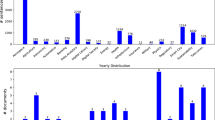Abstract
This chapter presents a methodology for identification of crosscutting concerns in textual requirements along with its supporting tool EA-Miner. This chapter discusses how EA-Miner uses natural language processing techniques in aspect identification and structuring using a requirements level feature model as an example. The process is illustrated using the Car Crash case study.
Access this chapter
Tax calculation will be finalised at checkout
Purchases are for personal use only
Similar content being viewed by others
Notes
- 1.
The details on concept identification are presented in [23].
- 2.
The model is derived using the ArborCraft tool. Any other way of model construction that has text related to the respective features would be equally suitable. Although the process of this specific model derivation is irrelevant to the present chapter, the interested reader is referred to [25] for more detail on ArborCraft and its use.
- 3.
This has been referred to as “in-text” variability in [25].
- 4.
This is a peculiarity of the ArborCraft tool used for the generation of the initial feature model. In this tool all text of the higher level features is also considered within the lower level ones.
References
V. Ambriola, V. Gervasi, Processing natural language requirements, in Proceedings of International Conference on Automated Software Engineering (IEEE Computer Society Press, Los Alamitos, 1997)
E. Baniassad, S. Clarke, Theme: An approach for aspect-oriented analysis and design, in Proceedings of the ICSE, Edinburgh, Scotland, 2004
E. Baniassad, S. Clarke, Theme: An approach for aspect-oriented analysis and design, in ICSE ’04: Proceedings of the 26th International Conference on Software Engineering (IEEE Computer Society, Washington, DC, 2004), pp. 158–167
BNC (British national corpus), http://www.natcorp.ox.ac.uk/. Accessed 15 Dec 2012
F.M. Burg, Linguistic Instruments in Requirements Engineering (IOS, Amsterdam, 1997)
L. Chung, B.A. Nixon, E. Yu, J. Mylopoulos, Non-Functional Requirements in Software Engineering (Kluwer, Boston, 2000)
L.M. Cysneiros, E. Yu, J.C.S.P. Leite, Cataloguing non-functional requirements as softgoals networks, in Workshop on Requirements Engineering for Adaptable Architectures at the International Requirements Engineering Conference (RE’03) (Monterey Bay, California, 2003), pp. 13–20
L.M. Cysneiros, J.C.S.P. Leite, Nonfunctional requirements: From elicitation to conceptual models. IEEE Trans. Software Eng. 30(5), 328–350 (2004)
J.N.O. Dag, B. Regnell, P. Carlshamre, M. Andersson, J. Karlsson, A feasibility study of automated natural language requirements analysis in market-driven development. Requir. Eng. 7(1), 20–33 (2002)
J.N.O. Dag et al., Speeding up requirements management in a product software company: Linking customerwishes to product requirements through linguistic engineering, in RE ’04: Proceedings of the Requirements Engineering Conference, 12th IEEE International (RE’04) (IEEE Computer Society, Washington, DC, 2004), pp. 283–294
A. Finkelstein, J. Kramer, B. Nuseibeh, L. Finkelstein, M. Goedicke, Viewpoints: A framework for integrating multiple perspectives in system development. Int. J. Software Eng. Knowl. Eng. 2(1), 31–57 (1992)
V. Gervasi, Environment Support for Requirements Writing and Analysis. PhD thesis, Universita Degli Studi de Pisa, 1999
L. Goldin, D.M. Berry, Abstfinder: A prototype natural language text abstraction finder for use in requirements elicitation. Automat. Software Eng. 4, 375–412 (1997)
I. Jacobson, M. Christerson, P. Jonsson, G. Övergaard, Object-oriented Software Engineering: A Use Case Driven Approach (Addison-Wesley, Reading, MA, 1992)
M. Luisa, F. Mariangela, I. Pierluigi, Market research for requirements analysis using linguistic tools. Requir. Eng. 9(1), 40–56 (2004)
M. Luisa, G. Roberto, Nl-oops: A requirements analysis tool based on natural language processing, in Proceedings of the 3rd International Conference on Data Mining, Bologna, 2002
M. Marin, A. Deursen, L. Moonen, Identifying aspects using fan-in analysis, in WCRE ’04: Proceedings of the 11th Working Conference on Reverse Engineering (IEEE Computer Society, Washington, DC, 2004), pp. 132–141
T. McEnery, A. Wilson, Corpus Linguistics (Edinburgh University Press, Edinburgh, 1996)
A. Moreira, A. Rashid, J. Araujo, Multi-dimensional separation of concerns in requirements engineering, in RE ’05: Proceedings of the 13th IEEE International Conference on Requirements Engineering (RE’05) (IEEE Computer Society, Washington, DC, 2005), pp. 285–296
A. Rashid, A. Moreira, J. Araujo, Modularisation and composition of aspectual requirements, in Proceedings of the 2nd International Conference on Aspect-Oriented Software Development (ACM, Boston, MA, 2003), pp. 11–20
A. Rashid, P. Sawyer, A. Moreira, J. Arajo, Early aspects: A model for aspect-oriented requirements engineering, in Proceedings of the International Conference on Aspect-Oriented Software Engineering (IEEE Computer Society Press, Los Alamitos, 2002), pp. 199–202
P. Rayson, Ucrel semantic analysis system (USAS), 2005, http://www.comp.lancs.ac.uk/ucrel/usas/. Accessed 15 Dec 2012
A. Sampaio, A. Rashid, R. Chitchyan, P. Rayson, Ea-miner: Towards automation in aspect-oriented requirements engineering. Trans. AOSD 4620(3), 4–39 (2007)
P. Sawyer et al., Revere: Support for requirements synthesis from documents. Inform. Syst. Front. 4(3), 343–353 (2002)
N. Weston, R. Chitchyan, A. Rashid, A framework for constructing semantically composable feature models from natural language requirements, in SPLC’09: Proceedings of the 13th International Software Product Line Conference, San Francisco, 2009, pp. 211–220
J. Whittle, J. Araujo, Scenario modeling with aspects. IEE Proc. Software 151(4), 157–172 (2004)
Y. Yu, J.C.S.P. Leite, J. Mylopoulos, From goals to aspects: Discovering aspects from requirements goal models, in Proceedings of the 12th IEEE International Requirements Engineering, Kyoto, Japan, 2004, pp. 38–47
Author information
Authors and Affiliations
Corresponding author
Editor information
Editors and Affiliations
Rights and permissions
Copyright information
© 2013 Springer-Verlag Berlin Heidelberg
About this chapter
Cite this chapter
Weston, N., Chitchyan, R., Sampaio, A., Rashid, A., Greenwood, P. (2013). Aspect Identification in Textual Requirements with EA-Miner. In: Moreira, A., Chitchyan, R., Araújo, J., Rashid, A. (eds) Aspect-Oriented Requirements Engineering. Springer, Berlin, Heidelberg. https://doi.org/10.1007/978-3-642-38640-4_1
Download citation
DOI: https://doi.org/10.1007/978-3-642-38640-4_1
Published:
Publisher Name: Springer, Berlin, Heidelberg
Print ISBN: 978-3-642-38639-8
Online ISBN: 978-3-642-38640-4
eBook Packages: Computer ScienceComputer Science (R0)




